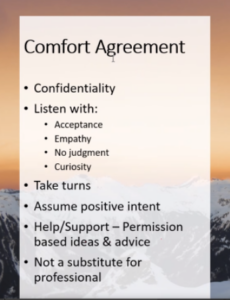When Jeff Christensen first had the idea for a group to support parents who are caring for a loved one with a mental health concern, he couldn’t have imagined what it would turn out to be. “With all the confidence of a four year-old in a Batman t-shirt,” he remembered, “we said, ‘we’re going to get this on the calendar.’”
You might remember Jeff from our Elevating Voices series. His son, Drew, tragically died by suicide at age 25 after a number of mental health diagnoses across the span of his life—from sensory auditory processing disorder when he was young, to bipolar 2 disorder in college, exacerbated by a severe fall that led to a traumatic brain injury, and head injuries from playing high school football.
Drew grew up with many advantages and a supportive family, but those advantages didn’t inoculate him from mental illness. Since his death, Jeff and his wife Nancy have become advocates for mental health services—and Jeff’s leadership at UnitedHealth Group is a recent example of him channeling the stores of resilience he has built up in the years since losing Drew.
Below, we’re sharing a bit more from Jeff about the work he is doing through Working Parents United, in hopes that it might inspire other organizations to start similar programs in support of their employees.
How It Started
Jeff brought his idea to the leader of Working Parents United—a UnitedHealth Group Employee Resource Group (ERG) that helps build community and connect employees to peer support. Soon, they were hosting their first meeting and working to build an advisory team of individuals with lived experience, organizational expertise and connections to leadership support.
Today, 90-120 people participate on each monthly call, and close to 500 people have joined since the group’s inception. They’ve outgrown the infrastructure supported by the software they were using—a clear indication of the overwhelming need for this type of conversation in the workplace.
How It’s Structured
The group is guided by an advisory team and enabled by an operations team. The advisory team is made up of both seasoned leaders and caregivers with lived experience who can identify with the pain their colleagues are going through, even if they don’t always know what to say. The advisory team sets the vision and objectives for the support group.
“There are people who are just beginning their journey, and there are people who are years, even decades into their journey of being a caregiver for a child or loved one with a mental health diagnosis,” Jeff shared. “People who are further along often have more resilience, and have more to give. Our goal is to create a safe and brave space for people—wherever they are on their journey—to discover they are not alone, and to offer support and reassurance that, ‘we are here for you.’”
The operations team helps with facilitation and administrative support. It’s a pool of volunteers who offer to host breakout sessions, manage the extensive resource page on the group’s Intranet landing page, and monitor the group chat.
A sample agenda for meetings looks something like this:
- A welcome and introductions, making clear the facilitators are not licensed mental health professionals (although they have some in attendance).
- A “comfort agreement”—a set of guidelines for participation that set the intention of creating a safe space.
- A trigger warning—inviting folks to drop out of the conversation or seek assistance from a therapist via their EAP if needed.
- News/featured updates, such as upcoming speakers, additions to the resource page, and more.
- Separating into breakout rooms. In the meeting, facilitated through Microsoft Teams, participants follow links to separate Outlook calendar invites for condition-specific support groups, including:
- ADHD
- Anxiety and OCD
- Autism Spectrum
- Depression
- Eating Disorders
- Severe Mental Illness
“After every monthly call, we have a facilitator debrief just to check in,” Jeff shares. “It can be really heavy and raw during the breakouts. We want to fix what’s broken and we can’t. We offer support and virtual hugs, but it’s important for us as facilitators to make time for each other after meeting – to listen and support, but also identify key themes that we need to account for in the next meeting.”
How It’s Going
When Jeff looks back on the times he, Nancy and their family were in the throes of Drew’s manic highs and depressive lows, he remembers “participating in suffering that probably wasn’t necessary.” In part due to stigma, and in part because they felt like Drew’s struggles were his story to tell, Jeff and Nancy isolated. “If someone has cancer, they probably have a CaringBridge,” Jeff says. “People are bringing over hotdish and praying for you. But with mental health, there’s a stigma and it’s the worst thing for those who are suffering—to feel like there’s nowhere to turn.”
“People need to find people who they can be their true authentic self with,” Jeff tells us. “Telling my story is hard. But creating a framework that leads people to make connections and find out they’re not alone—oh my goodness, that brings me joy. When people join the breakout sessions, and hear the stories of others, you can hear people taking that big sigh—coming up for air, finding they’re not alone. Sometimes that’s the little bit of renewed energy they need in order to take that next step.”
When we asked Jeff what he would share with other employers considering creating a similar group, he said: “We talk about work-life balance as if they’re two separate things. They’re not… they’re inseparable. Most employers are eager to retain their best employees and they want to help them to be productive, even when they are burdened with caregiving concerns. Many employers offer an EAP but they’re often underutilized. Sometimes when people find out they’re not alone, they’re more likely to reach out for resources like an EAP.”
“The Light Bringer”
 Through it all, Jeff has worked to ensure he takes care of himself and his family, so he is best prepared to help others. He meets with his VP at least once per month to connect on any needs related to this work. “We miss our son every day,” he said, “and the work that I do with the support group helps in my healing.”
Through it all, Jeff has worked to ensure he takes care of himself and his family, so he is best prepared to help others. He meets with his VP at least once per month to connect on any needs related to this work. “We miss our son every day,” he said, “and the work that I do with the support group helps in my healing.”
Outside of the office, Jeff takes special care of cardinals that visit his home—making sure the feeder is full and the water is fresh. “They remind me of my son,” he shares. He kayaks every month, rain or shine or even ice and snow—rolling at least once, proudly exclaiming, “I always come up!” But perhaps most profoundly, Jeff and Nancy recently welcomed their first grandchild into the world; “It’s amazing how a grandchild changes everything,” Jeff glowed.
Jeff’s grandson’s name is Luca, which means “light bringer,” and we can’t imagine a more apropos name for the grandson of a man who, through care, community building, intentional reflection, and a commitment to honor the memory of his son—is bringing light to so many.

